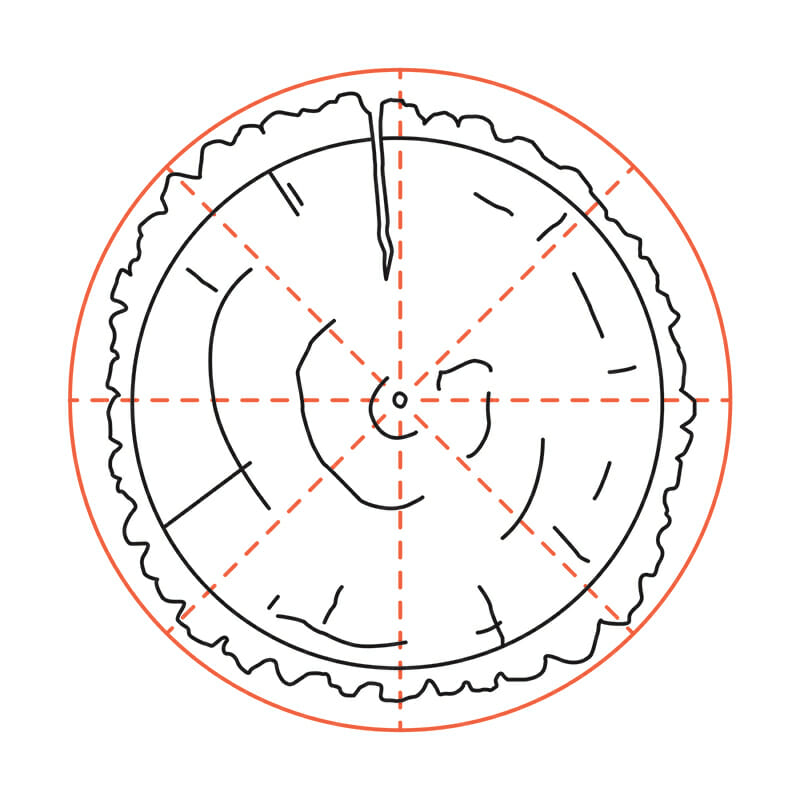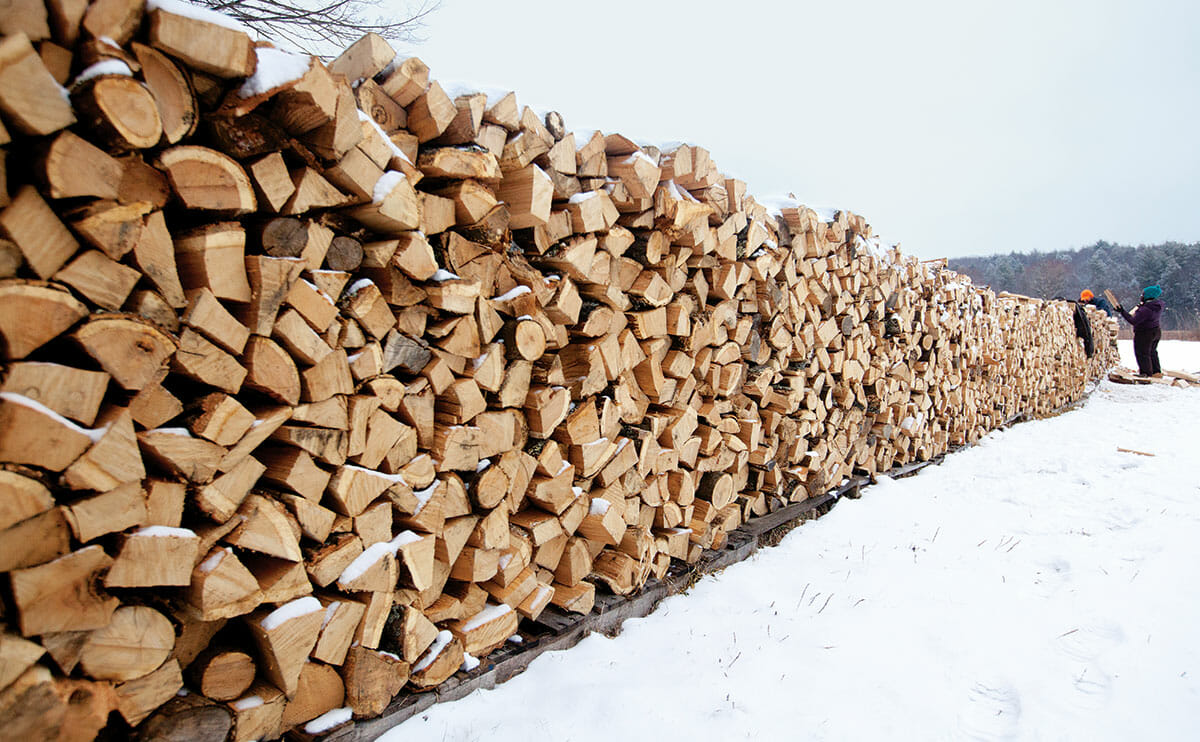How to Chop Wood
Baby, it’s cold outside. Learn how to chop wood like a pro lumberjack — without wrecking your back.
Chopping wood for an hour can boost male testosterone levels by almost 50 percent, says a group of University of California, Santa Barbara, researchers studying the Tsimane population of Bolivia. While many studies have examined the effect competition has on testosterone, lead researcher Ben Trumble instead chose to look at resource gathering and food production for a study published in 2012.
“In humans, men tend to compete for the attention of women via economic productivity as opposed to fighting other men in the street, so examining changes in testosterone during food production is important,” says Trumble. As for women, he speculates they would likely get a testosterone boost as well, though smaller.
But it’s likely you want more than a shot of testosterone: You want a neat stack of firewood, too. Grab an ax and get to work, right? Not so fast, cautions Shawn Swartz, forest manager at Warren Wilson College in Asheville, North Carolina. First off, forget the ax. Once the tree is felled and chopped up into logs, a maul (a sledgehammer-like contraption with a wedge on one end) is the tool of choice.
He also recommends some sturdy footwear, eye protection and a few splitting wedges for stubborn logs. And if the splitting wedges don’t work? “Well, I have a 37-ton mechanical splitter,” says Swartz, chuckling. “I’ve never met my match on that.”
For the rest of us, Swartz shows us the way:
Think about how you’ll be using the wood. If your wood stove can only fit an 18-inch log, cut your logs to 18 inches or less.
Keep your cuts even and square so the logs don’t tip over when placed on end.
This will raise the target of your chopping up, which saves your back and prevents your chopping instrument of choice from driving into the ground if you miss.
You want to cleave into the wood with the straightest grain first. “Imagine a broom squeezed together. These are like magnified wood fibers,” explains Swartz. When chopping a tree into logs, you’re cutting those fibers in half. When splitting those logs, you’re separating the fibers along the grain. Wood fibers tend to cross and get disorganized around knots and branch sites, and can foil a clean split.
Split the log like a pizza. “Don’t just shave off the edges,” says Swartz. Split it in half, then quarters. Keep going until you reach the desired size.

Let the maul or ax do the work. “People wear themselves out because they think they need to power their way through the whole split,” cautions Swartz. “All you’re really doing is getting the maul above your head and letting it fall into the wood.”
Save your back: Keep an arch in your lumbar spine, bend your knees and use your legs.
There’s more than one right way to swing, so if you find a way that works for you, go with it.
Practice precision by hitting the same spot over and over so that each swing adds to the progress made by the last.
Fresh-cut wood needs to sit for about a year to burn best. Opinions vary about whether to cover the wood, but Swartz says it’s not necessary to cover until a few weeks before you’re going to burn it. The idea is to dehydrate the wood fibers’ cells and bring the overall moisture content to below 20 percent.
“Rain only permeates between the cells. And rain dries.”

(Illustrations by MGMT. design.)
Follow us

This work is licensed under a Creative Commons Attribution-NoDerivatives 4.0 International License.
Want to republish a Modern Farmer story?
We are happy for Modern Farmer stories to be shared, and encourage you to republish our articles for your audience. When doing so, we ask that you follow these guidelines:
Please credit us and our writers
For the author byline, please use “Author Name, Modern Farmer.” At the top of our stories, if on the web, please include this text and link: “This story was originally published by Modern Farmer.”
Please make sure to include a link back to either our home page or the article URL.
At the bottom of the story, please include the following text:
“Modern Farmer is a nonprofit initiative dedicated to raising awareness and catalyzing action at the intersection of food, agriculture, and society. Read more at <link>Modern Farmer</link>.”
Use our widget
We’d like to be able to track our stories, so we ask that if you republish our content, you do so using our widget (located on the left hand side of the article). The HTML code has a built-in tracker that tells us the data and domain where the story was published, as well as view counts.
Check the image requirements
It’s your responsibility to confirm you're licensed to republish images in our articles. Some images, such as those from commercial providers, don't allow their images to be republished without permission or payment. Copyright terms are generally listed in the image caption and attribution. You are welcome to omit our images or substitute with your own. Charts and interactive graphics follow the same rules.
Don’t change too much. Or, ask us first.
Articles must be republished in their entirety. It’s okay to change references to time (“today” to “yesterday”) or location (“Iowa City, IA” to “here”). But please keep everything else the same.
If you feel strongly that a more material edit needs to be made, get in touch with us at [email protected]. We’re happy to discuss it with the original author, but we must have prior approval for changes before publication.
Special cases
Extracts. You may run the first few lines or paragraphs of the article and then say: “Read the full article at Modern Farmer” with a link back to the original article.
Quotes. You may quote authors provided you include a link back to the article URL.
Translations. These require writer approval. To inquire about translation of a Modern Farmer article, contact us at [email protected]
Signed consent / copyright release forms. These are not required, provided you are following these guidelines.
Print. Articles can be republished in print under these same rules, with the exception that you do not need to include the links.
Tag us
When sharing the story on social media, please tag us using the following: - Twitter (@ModFarm) - Facebook (@ModernFarmerMedia) - Instagram (@modfarm)
Use our content respectfully
Modern Farmer is a nonprofit and as such we share our content for free and in good faith in order to reach new audiences. Respectfully,
No selling ads against our stories. It’s okay to put our stories on pages with ads.
Don’t republish our material wholesale, or automatically; you need to select stories to be republished individually.
You have no rights to sell, license, syndicate, or otherwise represent yourself as the authorized owner of our material to any third parties. This means that you cannot actively publish or submit our work for syndication to third party platforms or apps like Apple News or Google News. We understand that publishers cannot fully control when certain third parties automatically summarize or crawl content from publishers’ own sites.
Keep in touch
We want to hear from you if you love Modern Farmer content, have a collaboration idea, or anything else to share. As a nonprofit outlet, we work in service of our community and are always open to comments, feedback, and ideas. Contact us at [email protected].by Dina Rudick, Modern Farmer
December 16, 2013
Modern Farmer Weekly
Solutions Hub
Innovations, ideas and inspiration. Actionable solutions for a resilient food system.
ExploreExplore other topics
Share With Us
We want to hear from Modern Farmer readers who have thoughtful commentary, actionable solutions, or helpful ideas to share.
SubmitNecessary cookies are absolutely essential for the website to function properly. This category only includes cookies that ensures basic functionalities and security features of the website. These cookies do not store any personal information.
Any cookies that may not be particularly necessary for the website to function and are used specifically to collect user personal data via analytics, ads, other embedded contents are termed as non-necessary cookies.

Hi